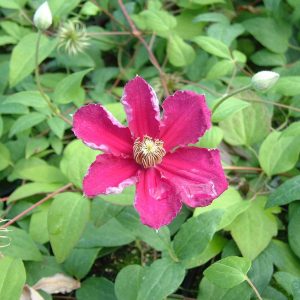Description
Cistus x corbariensis, also known as rock rose, is a small evergreen shrub that is valued for its attractive, fragrant flowers and its hardiness. The plant produces showy, saucer-shaped flowers in shades of pink, white, or purple that bloom in the late spring or early summer. The flowers are highly fragrant and attract pollinators such as bees and butterflies. The leaves are gray-green and provide a beautiful backdrop to the flowers. Rock rose is an excellent choice for adding color and interest to a mixed border or as a specimen plant. The plant is relatively low-maintenance and disease-resistant, making it a popular choice among gardeners. It can be pruned lightly after flowering to promote healthy growth and maintain its shape. The shrub can also be propagated by softwood or hardwood cuttings.
Key Facts
- Common Name(s):Hybrid rock rose
- Hardiness:Half hardy and would benefit from protection through Winter.
- How big will I get? Cistus x corbariensis can grow to a height of 0.6m and a spread of 1m.
- Did You Know That:The a single flower of Cistus species often only lasts a day? This is not too noticeable due to the number of flowers they produce!
Plant Calendar
A rough guide to how this plant will change through the year.
| Jan | Feb | Mar | Apr | May | June | July | Aug | Sept | Oct | Nov | Dec | |
| Flowering Time |  |
 |
||||||||||
| Foliage Colour |  |
 |
 |
 |
 |
 |
 |
 |
 |
 |
 |
 |
| J | F | M | A | M | J | J | A | S | O | N | D |
 |
 |
||||||||||
 |
 |
 |
 |
 |
 |
 |
 |
 |
 |
 |
 |
Care Guide

Soil Requirements
Cistus x corbariensis prefers soil with good drainage and does not tolerate standing water. This plant can grow in soil with a wide range of pH levels, it is not picky about the pH level of the soil.

Best Position
Cistus x corbariensis prefers a sheltered position and requires full sun to thrive, this consists of more than six hours of direct sunshine per day.

Maintenance
Cistus x corbariensis is fairly low maintenance and doesn’t require any pruning. Established plants can be damaged by any pruning as it makes them more susceptible to frost damage and they don’t respond well to it generally. Younger plants are more resilient to pruning and the leading stem and the larger sideshoots can be reduced by two thirds to try and encourage the plant to have a bushier form.

Pest, Diseases and Wildlife
Cistus x corbariensis is generally pest free, and it tends not to have problems with diseases.





